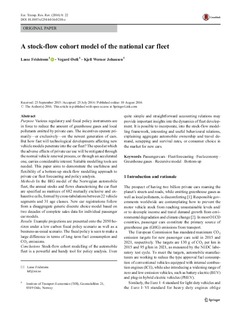| dc.contributor.author | Fridstrøm, Lasse | |
| dc.contributor.author | Østli, Vegard | |
| dc.contributor.author | Johansen, Kjell Werner | |
| dc.coverage.spatial | Norway | nb_NO |
| dc.date.accessioned | 2019-06-27T07:19:37Z | |
| dc.date.available | 2019-06-27T07:19:37Z | |
| dc.date.created | 2016-10-13T09:43:48Z | |
| dc.date.issued | 2016-08-10 | |
| dc.identifier.citation | European Transport Research Review. 2016, 8 (22), . | nb_NO |
| dc.identifier.issn | 1867-0717 | |
| dc.identifier.uri | http://hdl.handle.net/11250/2602442 | |
| dc.description.abstract | Purpose
Various regulatory and fiscal policy instruments are in force to reduce the amount of greenhouse gases and local pollutants emitted by private cars. The incentives operate primarily—or exclusively—on the newest generation of cars. But how fast will technological developments affecting new vehicle models penetrate into the car fleet? The speed at which the adverse effects of private car use will be mitigated through the normal vehicle renewal process, or through an accelerated one, carries considerable interest. Suitable modelling tools are needed. This paper aims to demonstrate the usefulness and flexibility of a bottom-up stock-flow modelling approach to private car fleet forecasting and policy analysis.
Methods
In the BIG model of the Norwegian automobile fleet, the annual stocks and flows characterising the car fleet are specified as matrices of 682 mutually exclusive and exhaustive cells, formed by cross-tabulations between 22 vehicle segments and 31 age classes. New car registrations follow from a disaggregate generic discrete choice model based on two decades of complete sales data for individual passenger car models.
Results
Example projections are presented onto the 2050 horizon under a low carbon fiscal policy scenario as well as a business-as-usual scenario. The fiscal policy is seen to make a large difference in terms of long term fuel consumption and CO2 emissions.
Conclusions
Stock-flow cohort modelling of the automobile fleet is a powerful and handy tool for policy analysis. Even quite simple and straightforward accounting relations may provide important insights into the dynamics of fleet development. It is possible to incorporate, into the stock-flow modelling framework, interesting and useful behavioural relations, explaining aggregate automobile ownership and travel demand, scrapping and survival rates, or consumer choice in the market for new cars. | nb_NO |
| dc.language.iso | eng | nb_NO |
| dc.publisher | Springer Berlin Heidelberg | nb_NO |
| dc.rights | Navngivelse 4.0 Internasjonal | * |
| dc.rights.uri | http://creativecommons.org/licenses/by/4.0/deed.no | * |
| dc.title | A stock-flow cohort model of the national car fleet | nb_NO |
| dc.title.alternative | A stock-flow cohort model of the national car fleet | nb_NO |
| dc.type | Journal article | nb_NO |
| dc.type | Peer reviewed | nb_NO |
| dc.rights.holder | © The Author(s) 2016 | nb_NO |
| dc.description.version | publishedVersion | nb_NO |
| cristin.unitcode | 7482,3,1,0 | |
| cristin.unitname | Samfunnsøkonomiske analyser | |
| cristin.ispublished | true | |
| cristin.fulltext | original | |
| cristin.qualitycode | 1 | |
| dc.identifier.doi | 10.1007/s12544-016-0210-z | |
| dc.identifier.cristin | 1391397 | |
| dc.source.journal | European Transport Research Review | nb_NO |
| dc.source.volume | 8 | nb_NO |
| dc.source.issue | 22 | nb_NO |
| dc.source.pagenumber | 15 | nb_NO |
| dc.relation.project | Norges forskningsråd: 195191 | nb_NO |

